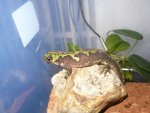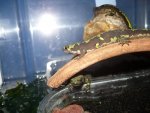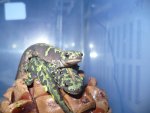Re: T. marmoratus question.
Well, if they have a raised crest with a banded pattern, then they are male for sure.
The darker coloration is normal when they are becoming aquatic. Some get very dark, others retain a bright coloration although usually not as bright as whe they were terrestrial.
I don´t see any reason to separate them, the males might display, but if the females are not interested, nothing will happen, and females should take a while longer to be ready.
It seems to me that they are becoming fully aquatic, which means you should provide lots of water (preferably heavily planted), and feed them in the water, if going aquatic is what you want for them. They might take the odd stroll on land, but they might also be 100% aquatic for a good while. Always offer some land, though.






 Axolotl Enthusiast
Axolotl Enthusiast